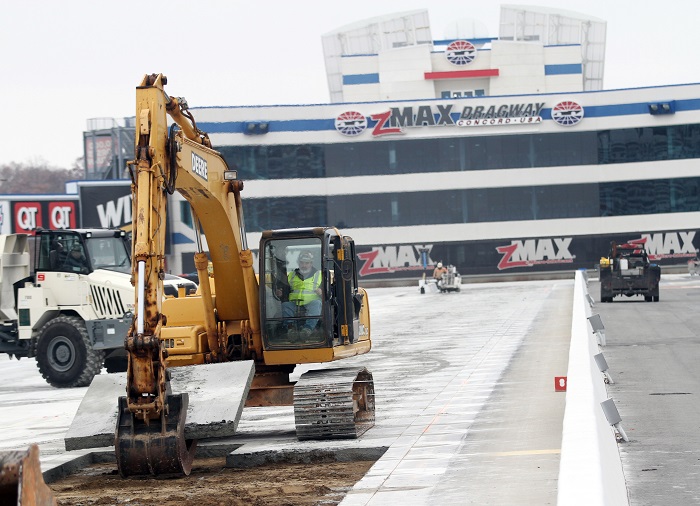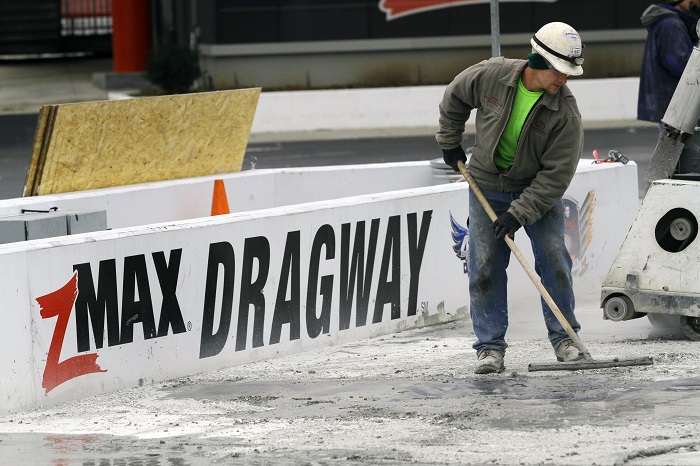ZMAX DRAGWAY BEGINS RECONSTRUCTION OF RACING SURFACE
 zMax Dragway GM Christian Byrd confirmed today the "drag strip" located on the grounds of Charlotte Motor Speedway will replace all four lanes of the drag strip for the 2015 season. Byrd told CompetitionPlus.com he expects the project to be completed by February 2015.
zMax Dragway GM Christian Byrd confirmed today the "drag strip" located on the grounds of Charlotte Motor Speedway will replace all four lanes of the drag strip for the 2015 season. Byrd told CompetitionPlus.com he expects the project to be completed by February 2015.
The new strip will be a combination of concrete and asphalt, and will be adjusted to make a continual one-percent downhill grade.
"We are going to convert the concrete at about 700 feet to an asphalt racing surface," Byrd said. "We started demolition about a week and a half ago. The asphalt will go down as soon as we finish, and plan to begin laying concrete in January. We expect to have race cars on the track in mid-February."

 zMax Dragway GM Christian Byrd confirmed today the "drag strip" located on the grounds of Charlotte Motor Speedway will replace all four lanes of the drag strip for the 2015 season. Byrd told CompetitionPlus.com he expects the project to be completed by February 2015.
zMax Dragway GM Christian Byrd confirmed today the "drag strip" located on the grounds of Charlotte Motor Speedway will replace all four lanes of the drag strip for the 2015 season. Byrd told CompetitionPlus.com he expects the project to be completed by February 2015.
The new strip will be a combination of concrete and asphalt, and will be adjusted to make a continual one-percent downhill grade.
"We are going to convert the concrete at about 700 feet to an asphalt racing surface," Byrd said. "We started demolition about a week and a half ago. The asphalt will go down as soon as we finish, and plan to begin laying concrete in January. We expect to have race cars on the track in mid-February."
The one-percent continuation removes a "ski-jump" scenario as described by a veteran drag racer.
"This was a trouble spot for many of the Pro Stock and Pro Modified teams," Byrd explained. "We will make it a continual plain and shouldn't disrupt the wheelie bar. This will make more testing data relevant for these teams choosing to test."
Byrd is ready to put a tumultuous fall of 2014 behind him, and said his team didn't rush to any quick conclusions on diagnosing the issues plaguing the drag strip's racing surface.
"We spent a lot of time in analyzing and diagnosing the problems we were having [with the racing surface]," Byrd explained. "We had the experts weigh in and at the end of the day; this was the right course of action to correct the issues we've faced on and off for the last couple of years. Hopefully, we will return with a record-setting surface."
 Byrd said the decision to go with the concrete/asphalt combination was based on the number of tracks available to which they could draw data from.
Byrd said the decision to go with the concrete/asphalt combination was based on the number of tracks available to which they could draw data from.
"We just felt there was more data out there with that combination versus having one of two all-concrete racing surfaces," Byrd said. "When these cars go one-to-one in the clutch they are creating tremendous downforce and vacuum on the track, so it eliminated one of the variables that could contribute to the concrete issues. We decided to eliminate this variable."
Byrd said the concrete issue is one which didn't exist when the facility was first built in 2008. He described the issue as ASL, also known in concrete terms as Alkili-silica Reaction.
"This is basically the process of a chemical reaction transpiring around the aggregate itself," explained Byrd. "This causes the concrete to degrade itself. Several things can contribute to this ASR. You more commonly see this in bridge issues. It's not really a bad mix of concrete because the spec on the concrete we used was stronger than anyone recommended at the time. It's just the problem expedited the failure of the concrete."
Byrd wouldn't say there is anyone to blame.
"It was important we went back and did our due diligence, and not just jump in, do this over and have the same thing happen again," Byrd explained. "We went it to labs in Ohio; we took good core samples and samples where it was bad, and because of that we can eliminate the propensity for ADSR."
"We have the right group of people and others working hard to make sure this doesn't happen again. We are committed to being the best and no reason we shouldn't be able to achieve this goal."
The act of cutting and pasting articles from this publication to a message board is a clear copyright violation as is pulling photos to post on social media sites. All articles and photography published in CompetitionPlus.com are protected by United States of America and International copyright laws unless mentioned otherwise. The content on this website is intended for the private use of the reader and may not be published or reposted in any form without the prior written consent of CompetitionPlus.com.





































